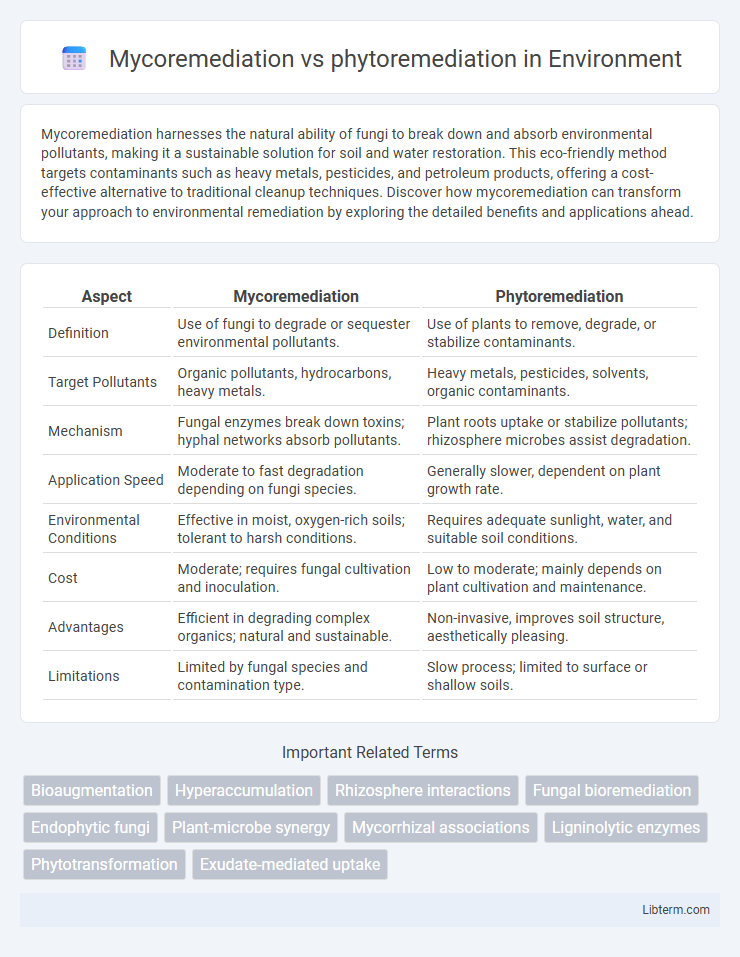Mycoremediation harnesses the natural ability of fungi to break down and absorb environmental pollutants, making it a sustainable solution for soil and water restoration. This eco-friendly method targets contaminants such as heavy metals, pesticides, and petroleum products, offering a cost-effective alternative to traditional cleanup techniques. Discover how mycoremediation can transform your approach to environmental remediation by exploring the detailed benefits and applications ahead.
Table of Comparison
| Aspect | Mycoremediation | Phytoremediation |
|---|---|---|
| Definition | Use of fungi to degrade or sequester environmental pollutants. | Use of plants to remove, degrade, or stabilize contaminants. |
| Target Pollutants | Organic pollutants, hydrocarbons, heavy metals. | Heavy metals, pesticides, solvents, organic contaminants. |
| Mechanism | Fungal enzymes break down toxins; hyphal networks absorb pollutants. | Plant roots uptake or stabilize pollutants; rhizosphere microbes assist degradation. |
| Application Speed | Moderate to fast degradation depending on fungi species. | Generally slower, dependent on plant growth rate. |
| Environmental Conditions | Effective in moist, oxygen-rich soils; tolerant to harsh conditions. | Requires adequate sunlight, water, and suitable soil conditions. |
| Cost | Moderate; requires fungal cultivation and inoculation. | Low to moderate; mainly depends on plant cultivation and maintenance. |
| Advantages | Efficient in degrading complex organics; natural and sustainable. | Non-invasive, improves soil structure, aesthetically pleasing. |
| Limitations | Limited by fungal species and contamination type. | Slow process; limited to surface or shallow soils. |
Introduction to Mycoremediation and Phytoremediation
Mycoremediation utilizes fungi to degrade or sequester environmental contaminants, harnessing fungal enzymes like laccases and peroxidases to break down pollutants such as hydrocarbons and heavy metals. Phytoremediation employs plants to absorb, stabilize, or detoxify contaminants through processes like phytoextraction, phytostabilization, and phytodegradation, targeting pollutants including heavy metals, pesticides, and organic compounds. Both bioremediation techniques offer sustainable, cost-effective solutions for soil and water remediation by leveraging natural biological mechanisms to restore contaminated ecosystems.
Defining Mycoremediation: Mechanisms and Applications
Mycoremediation is the process of using fungi to degrade or sequester environmental contaminants through enzymatic breakdown and absorption. Fungi produce extracellular enzymes like lignin peroxidase and laccase, which can decompose complex pollutants such as hydrocarbons, heavy metals, and pesticides. This technique finds application in soil decontamination, wastewater treatment, and restoring ecosystems affected by industrial pollution.
Understanding Phytoremediation: Processes and Types
Phytoremediation involves using plants to remove, stabilize, or degrade contaminants from soil and water through processes like phytoextraction, phytostabilization, phytodegradation, and rhizofiltration. These mechanisms enable the uptake and accumulation of heavy metals, organic pollutants, and radionuclides, making it an eco-friendly remediation technique. Understanding the specific type of phytoremediation is crucial for selecting appropriate plant species and optimizing conditions for effective contaminant removal.
Pollutants Targeted by Mycoremediation vs Phytoremediation
Mycoremediation targets organic pollutants such as petroleum hydrocarbons, pesticides, and industrial dyes by utilizing fungi's enzymatic breakdown capabilities, while phytoremediation primarily focuses on heavy metals, radionuclides, and nutrients like nitrogen and phosphorus through plant uptake and stabilization. Fungal species like white rot fungi degrade complex hydrocarbons and toxics, whereas hyperaccumulator plants absorb and concentrate metal contaminants from soil and water. Both methods complement each other by addressing diverse pollutant classes in contaminated environments.
Environmental Benefits of Mycoremediation
Mycoremediation leverages fungi's ability to break down complex pollutants like hydrocarbons and heavy metals into less toxic compounds, offering a powerful tool for restoring contaminated soils and water. Unlike phytoremediation, fungi can degrade a wider range of organic contaminants due to their enzymatic capabilities, enhancing ecosystem recovery. This method improves soil health by increasing nutrient availability and microbial diversity, promoting sustainable environmental remediation.
Environmental Benefits of Phytoremediation
Phytoremediation utilizes plants to absorb, accumulate, and detoxify pollutants, offering a cost-effective and eco-friendly solution for soil and water restoration. This method enhances biodiversity, stabilizes contaminated sites, and improves soil structure, facilitating long-term ecosystem recovery. Phytoremediation also reduces the risk of erosion and leaching, making it a sustainable strategy for managing heavy metals, pesticides, and organic contaminants.
Limitations and Challenges: Mycoremediation vs Phytoremediation
Mycoremediation faces challenges such as slower degradation rates and sensitivity to environmental conditions like pH and moisture levels, limiting its effectiveness in certain contaminated sites. Phytoremediation is constrained by plant growth rates, metal accumulation capacity, and the risk of biomagnification in the food chain. Both methods require site-specific assessments to address limitations in pollutant types, soil depth, and climate adaptability for optimal remediation outcomes.
Case Studies: Success Stories in Mycoremediation
Successful case studies in mycoremediation demonstrate fungi's remarkable ability to degrade petroleum hydrocarbons in oil-contaminated soils, as seen in the Exxon Valdez spill recovery efforts. In a landmark project in India, oyster mushrooms (Pleurotus ostreatus) were used to effectively break down dyes and heavy metals in industrial wastewater. These studies highlight the efficacy of fungal enzymes in transforming complex pollutants into less toxic compounds, offering a sustainable alternative to traditional remediation methods.
Case Studies: Success Stories in Phytoremediation
Phytoremediation case studies reveal significant success in using plants like sunflowers and poplars to extract heavy metals and organic pollutants from contaminated soils, such as at the U.S. Department of Energy's Hanford Site. These studies demonstrate effective remediation of arsenic, lead, and petroleum hydrocarbons through targeted plant species, showcasing cost-efficiency and ecological benefits compared to conventional methods. Mycoremediation, utilizing fungi like white-rot species, shows promise in degrading complex pollutants but still requires further large-scale validation to match the documented successes of phytoremediation in field applications.
Future Prospects and Integration of Both Technologies
Future prospects of mycoremediation and phytoremediation highlight their potential synergy in enhancing environmental cleanup efficiency, particularly for complex contaminants like heavy metals and organic pollutants. Integrating fungal mycelium with phytoremediative plants can optimize pollutant degradation rates, improve soil health, and promote sustainable land restoration practices. Advances in genetic engineering and biotechnological methods aim to enhance tolerance and effectiveness, paving the way for the combined application of these biological remediation techniques in large-scale environmental management.
Mycoremediation Infographic

 libterm.com
libterm.com